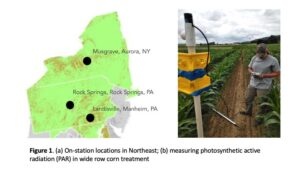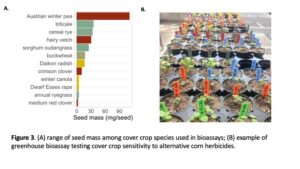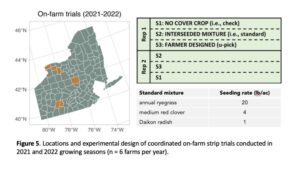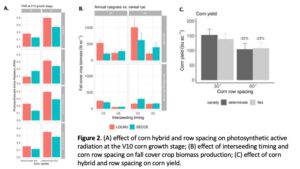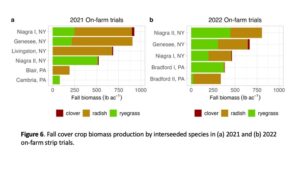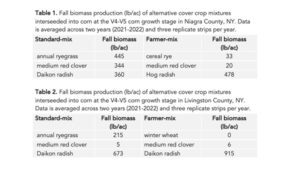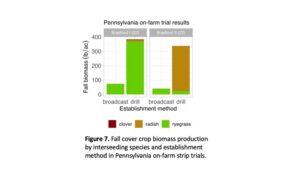Final report for LNE20-404
Project Information
Our project engaged PA and NY corn grain growers in educational activities that focused on improving cover crop interseeding best management practices (BMPs) to foster more widespread adoption of cover cropping. Grower engagement and preproposal surveys suggest two primary challenges that prevent expansion of interseeding practices in the Northeast. First, farmers are unwilling to invest resources to interseed cover crops without assurance that conservation and production benefits of interseeded cover crops will be consistently realized. Second, the performance of interseeded cover crops is a function of context-dependent interactions between climate, soil and crop management practices. Our project utilized research and extension programs to support the development of regionally-specific cover crop interseeding BMPs.
Three research activities were completed to address these objectives. An on-station experiment was conducted in 2020 to identify specific combinations of management practices that increase biomass production and decrease spatial- and temporal- variability of interseeded cover crops by manipulating cash crop (corn hybrid, population rates, row spacing) and cover crop (establishment timing, species) interactions. Our results show that interseeding at the V3 corn growth stage in 30” row spacing lengthens the establishment period prior to rapid corn canopy closure compared to interseeding at the V6 growth stage and may increase the competitive advantage of cover crops over weeds. Differences in leaf architecture among determinate and flex-ear hybrids produced marginal effects on light transmittance when using 30” rows and played a limited role in mediating cover crop and weed interactions. Reduction in corn yield observed within wide row corn (60”) was not consistently offset by a significant increase in cover crop performance due to increased weed competition with the cool season cover crop species (cereal rye, annual ryegrass, medium red clover) used in this study.
Results from 2020 field experiments indicated that weed control is likely a significant agronomic factor that limits the potential of integration of cover crop mixtures in either narrow- or wide- row corn. In 2021, we conducted a graduate-student designed field experiment that focused on evaluation of cover crop species tolerance to a gradient of herbicide management strategies for early-interseeding based on taxonomic and seed-size difference in cover crop species. Complementary greenhouse experiments were completed to create relative-risk ratings for twelve cover crop species for common corn herbicides. Our results showed that in fields where weed pressure is high, use of longer-lived residual herbicides to provide adequate weed control may result in net benefits despite increased risk of injury to cover crops due to the subsequent decrease in weed competition. Our results showed that using larger-seeded cover crop species (e.g., winter cereals, Austrian winter pea, cow-pea) increases herbicide tolerance at the establishment phase, but these species may also be less shade tolerant beneath a corn canopy compared to smaller-seeded species (annual ryegrass, medium red clover). These findings demonstrate how both herbicide tolerance and environmental stress tolerance should be considered to select suitable candidate species for interseeding.
During the project period, four farmers in Pennsylvania and four farmers in western NY participated in on-farm strip trials. A common cover crop mixture (annual ryegrass, medium red clover, forage radish) was interseeded across all locations, allowing growers to evaluate performance under their management conditions relative to other regions, and to a farmer-designed treatment. Only four locations chose to compare the common mixture to their own designed treatment. Participating farmers and professionals learned the value of drill-interseeding at earlier growth stages compared to broadcast interseeding and how establishment method and herbicide selection can impact the expression of the cover crop mixture, as well as total biomass production. Farmers also learned that winter cereals are probably less suitable for cover crop interseeding compared to annual ryegrass, which proved to be more consistent across locations.
Research results and interseeding BMPs were communicated to 5,640 individuals during the length of this project using a combination of field day presentations, webinars, podcasts and videos. Our presentations generated 225 survey responses from either farmers or agricultural service providers indicated changes in attitude, behavior or knowledge of interseeding practices.
Fifty agronomic farmers will implement a management practice that facilitates adoption or improves performance of interseeding cover crops in corn on 100 acres per farm. Changes in management practices will decrease soil erosion potential, decrease nitrate-N leaching, and increase weed suppression on 5,000 acres in the Northeast region.
Integrating winter cover crops in annual cropping systems can provide important conservation and crop production benefits at field and watershed scales, yet recent surveys indicate that greater than 60% of grain crop acres in PA and NY remain fallow in winter. Farmers have considered post-harvest seeding cover crops a poor return on investment because of the limited growing season to establish cover crops following corn grain or soybean harvest. However, increasing interest in soil health has raised farmer awareness of alternative practices, including interseeding cover crops into corn earlier in the growing season. The recent development and commercial availability of high-clearance interseeder drills facilitates cover crop establishment early in the season (V5 corn growth stage) and applied research and extension programs within the Northeast have developed best management practices (BMPs) for drill-interseeding cover crops in no-till corn. Grower engagement and preproposal surveys suggest two primary challenges that prevent expansion of interseeding practices in the Northeast. First, farmers are unwilling to invest resources to interseed cover crops without assurance that conservation and production benefits of interseeded cover crops will be consistently realized. Second, the performance of interseeded cover crops is a function of context-dependent interactions between climate, soil and crop management practices. Our project utilized research and extension programs to support the development of regionally-specific cover crop interseeding BMPs.
Cooperators
- (Researcher)
- (Educator and Researcher)
- (Educator and Researcher)
Research
We hypothesized that: (1) specific combinations of corn, cover crop and weed management practices increase cover crop biomass production and function; (2) management practices that increase temporal and spatial resources to interseeded cover crops will be positively correlated with cover crop biomass production; and (3) management practices that optimize performance of interseeded cover crops will vary based on environmental conditions.
Complementary on-station experiments and on-farm strip trials were conducted to address research hypotheses focusing on interactions between climate, soil, and management factors that influence cover crop interseeding performance. The design of on-station experiments and on-farm strip-trials were in direct response to identified farmer constraints to adoption, which we collected from input at previous workshops and conferences, as well as a pre-proposal survey of agricultural service providers and SWCDs working directly with farmers through interseeding programs.
On-Station (2020): Cultural practices for improving interseeding performance. An on-station experiment was conducted in 2020 to identify specific combinations of management practices that increase biomass production and decrease spatial- and temporal- variability of interseeded cover crops by manipulating cash crop (corn hybrid, population rates, row spacing) and cover crop (establishment timing, species) interactions. The field experiment was conducted at Cornell's Musgrave Research Farm in Aurora NY and Penn State research farms in Rock Springs, PA (RELARC) and Landisville, PA (SEARC). These stations span three USDA plant hardiness zones (6a, 6b, 7a) and encompass the range of climatic and soil conditions found in Northeast regions targeted for on-farm trials and educational activities.
Treatments were corn hybrid (determinate variety ZS9598 or a flex-ear hybrid LC0057) and standard versus wide row spacing (30” or 60”). Plots were split by cover crop interseeding timing (V3 or V6 corn growth stage) and cover crop species (cereal rye (Secale cereale L.) sown at 90 lb/ac, annual ryegrass (Lolium multiflorum L.) at 25 lb/ac, and medium red clover (Trifolium pratense L.) at 15 lb/ac.
On-Station (2021-2022): Balancing weed control and interseeding performance. Results from 2020 field experiments indicated that weed control is likely a significant agronomic factor that limits the potential of wide-row interseeding, as well integration of cover crop mixtures in narrow- or wide- row corn. Consequently, we initiated a graduate student designed (M.Sc. student, Mazzone) field experiment in the 2021 growing season and replicated at three locations (Landisville PA, Rock Springs PA, Aurora NY). The field experiment focused on evaluation of cover crop species tolerance to a gradient of herbicide management strategies for early-interseeding based on taxonomic and seed-size difference in cover crop species. Complementary greenhouse experiments were conducted to assess the relative sensitivity of 12 cover crops species to 5 common corn herbicide programs. This work supported field-based experiments while expanding inferences to a greater number of cover crop species and is intended to inform decision making that aims to integrate high-diversity mixtures in narrow- or wide- row corn, while maintaining weed control to meet crop protection goals and to maximize cover crop services.
Cover crop treatments included two cover crop mixtures and a cereal rye (Secale cereale L.) monoculture. Cover crop mixtures varied in cover crop seed mass, including a large-seeded and small-seeded mixture of grass, legume, and brassica species. The large-seeded mix included cereal rye (60 lb/ac), cowpea (5 lb/ac) and daikon radish (1 lb/ac), which was designed as a strategy to increase diversity during the corn growing season while resulting in a cereal rye spring cover crop prior to a soybean phase due to winter-killed brassica and legume species. The small-seeded species mixture included annual ryegrass (20 lb/ac), medium red clover (4 lb/ac) and rapeseed (1 lb/ac), which includes three winter-hardy species. Herbicide treatments included treatments at corn planting (PRE) compared to a no-PRE control that included a POST glyphosate application. Based on previous field research, herbicide treatments comprised: 1) a short-lived residual herbicide program with primarily grass weed activity (saflufenacil + dimethenamid-P; Verdictâ); 2) a residual program with an intermediate level of persistence, and which increased broadleaf activity (acetochlor + atrazine; Harnessâ + Aatrexâ) relative to the short-lived treatment; 3) a longer-lived residual with both grass and weed activity (S-metolachlor + mesotrione + atrazine; Lumaxâ). Thus, the herbicide treatment levels in the PRE experiment were designed to represent a potential herbicide injury gradient by including herbicides that ranged in length of expected residual weed control activity to test the hypothesis that there may be a herbicide tolerance advantage of larger seeded cover crop species to survive longer-lived residual herbicide programs compared to smaller seeded cover crop species.
Greenhouse (2021-2022): Developing relative-risk ratings for corn herbicides. In support of field experiments, we conducted a series of greenhouse dose response assays that evaluated the response of twelve cover crop species to commonly used corn herbicides, including atrazine applied alone or in combination with HPDD inhibitors such as Callisto, Balance Flexx, Laudis or Impact. Greenhouse trials used a three-factor randomized complete block design with five replicates and two experimental runs. Experimental factors included cover crop species, herbicides, and herbicide rates based on standard label rates for medium-textured soils in corn. Cover crop species included annual ryegrass (Kodiak), cereal rye (VNS), triticale (Elevator), sorghum sudangrass (AS5201), crimson clover (Dixie), medium red clover (VNS), hairy vetch (Purple Bounty), Austrian winter pea, winter canola (Wichita), Daikon radish, forage rape (Dwarf Essex), and buckwheat (Lifago). Experiment units (pots) were filled with 2:1 sand to potting mix medium and sown with five cover crop species prior to application of herbicides at 15 gpa in a track sprayer. Aboveground biomass was harvested 28 DAT, dried and weighed. Non-linear models were fit for each herbicide by cover crop combination and the ED50 parameter estimate and 95% confidence intervals were used to compare relative sensitivities.
The primary objective of this study was to estimate the relative sensitivity of cover crop species within herbicide programs to inform selection of interseeded or post-harvest seeded cover crop species when the management goal requires diverse cover crop mixtures or integrating diverse species into cover cropping practices. To facilitate these comparisons, a risk-rating was developed using the nearest simulated soil half-life to estimated absolute ED50 values. Consequently, low ED50 values represent high injury risk because significant biomass reduction may occur at low concentrations in soil that may be present for extended periods of time. High estimated ED50 values represent low risk of injury in response to a given herbicide program because the concentration in field soils necessary to significantly reduce cover growth is expected to be present for a shorter duration. A low risk rating (i.e., high absolute ED50 values) is likely necessary to consistently establish cover crop species when drill-interseeding cover crops at early corn growth stages.
2021-2022 Coordinated On-Farm Strip Trials. Across the 2021 and 2022 production season, coordinated on-farm strip trials were conducted at nine locations in western NY (n = 5) and six locations. A common cover crop mixture (annual ryegrass, medium red clover, forage radish) was interseeded across locations, allowing growers to evaluate performance under their management conditions relative to non-interseeded paired strips and a farmer-designed treatment. Only four locations chose to compare the common mixture to their own designed treatment. In western NY, producers that participated in 2021-2022 participated again in 2022-2023. In 2021, we cooperated Penn State Extension (Z. Larson) to conduct strip trials in Blair and Cambria County within Pennsylvania. In 2022, we collaborated with the Bradford County Soil Water Conservation District (K. Brown), which provides interseeding services to growers using a high-boy interseeder. At these locations, we compared drill inter-seeding to broadcast interseeding at the V4 growth stage. Mid-season evaluations include estimates of cover crop establishment rates and late-fall and early spring cover crop biomass was taken at each location and summarized in a trial report given to the farmer network.
On-Station (2020): Cultural practices for improving interseeding performance.
Results showed that light transmittance through the corn canopy was greater in 60” row spacing compared to 30” row spacing at the V6 growth stage, with the magnitude of difference increasing at the V10 corn growth stage (Figure 2a). Corn hybrids had a marginal effect on light transmittance.
The effect of row spacing and interseeding timing on fall cover crop biomass varied across cover crop species and locations. In 30” rows, interseeding earlier (V3) increased cover crop biomass production. At the southern location (Landisville, PA), biomass production of grass cover crops, annual ryegrass and cereal rye, were minimal by the time of corn harvest. Interseeding at the V3 growth stage resulted in greater fall biomass production of annual ryegrass compared to cereal rye at the northern location (Aurora, NY), with few differences among grass species observed at Rock Springs, PA. (Figure 2b). When averaged across species, the competitive advantage of cover crops was greater than weeds in each combination of cultural practices that included narrow row spacing (30”), whereas the competitive advantage of weeds was greater than cover crops when interseeding in wide rows (60”). The effect of row spacing on corn yield varied among locations, with higher yields observed in 30” row spacing compared to 60” row spacing at Aurora NY and Landisville PA, but not at Rock Springs PA. Use of determinate hybrids on 60” row spacing resulted in a 32% yield reduction compared to narrow spacing when averaged across locations, whereas use of flex-ear hybrids resulted in a 23% yield reduction (Figure 2c).
On-Station (2021-2022): Balancing weed control and interseeding performance.
Small-seeded cover crop mixtures generally produced less biomass compared to the large-seeded cover crop mixture during the establishment phase from approximately the V4 to V8 corn growth stage. The most northern site (Aurora, NY) produced the greatest biomass during the establishment phase. Herbicide treatment effects on cover crops varied by site, where longer-lived herbicides reduced cover crop establishment and persistence at all sites, while shorter-lived residual herbicides did not negatively impact cover crop biomass directly. Instead, shorter-lived herbicides failed to control weeds at southern locations that were characterized by greater weed pressure, likely contributing to biomass reduction during cover crop establishment and persistence. These findings suggest that in fields where weed pressure is high, use of longer-lived residual herbicides to provide adequate weed control may result in net benefits despite increased risk of injury to cover crops due to the subsequent decrease in weed competition. Though larger-seeded species may increase herbicide tolerance at the establishment phase, these species may also be less shade tolerant beneath a corn canopy compared to smaller-seeded species. Just prior to corn harvest, the large-seeded cover crop mixture and cereal rye monoculture contained almost no cereal rye due to late summer mortality. In comparison, the small-seeded mixture was more variable in mixture composition due to herbicide effects in both trials when measured at corn grain harvest. These findings demonstrate how both herbicide tolerance and environmental stress tolerance should be considered to select suitable candidate species for interseeding.
Greenhouse (2021-2022): Developing relative-risk ratings for corn herbicides.
These results provide decision-support for pairing cover crop species in mixtures that express a similar level of sensitivity, or tolerance, to various corn herbicide programs (atrazine, atrazine/HPPD). Results demonstrated that cover crop relative sensitivity differed between both cover crop seed mass as well as cover crop plant family for several herbicide programs. In general, brassica species were more tolerant to topramezone/atrazine and tolpyralate/atrazine than annual ryegrass and therefore could be considered as a potential component of an interseeded mixture in production systems where annual ryegrass consistently establishes when using these herbicide programs. Buckwheat, cereal grains, and large-seeded legumes showed similar tolerance levels to atrazine, isoxaflutole/atrazine, topramezone/atrazine and tolpyralate/atrazine when compared to annual ryegrass, indicating potential for these species to be included in mixtures with annual ryegrass when interseeding. Conversely, small-seeded legumes such as clovers were significantly more sensitive than annual ryegrass for all herbicide mixtures screened, indicating that caution should be used when integrating these small-seeded legume species into interseeded cover crop mixtures.
Coordinated On-Farm Strip Trials (2021-2022).
Fall cover crop biomass production varied widely across locations, with no detectable correlation between cover crop biomass and production region or corn yield. Total fall biomass production taken in in late fall, approximately 3 to 4 weeks after corn grain harvest, ranged from less than 100 lb/ac to 900 lb/ac (Figure 6). Medium red clover was a negligible component of cover crop mixtures across allocation locations, whereas forage radish and annual ryegrass production varied considerably. At several locations, either the lack of annual ryegrass establishment or forage radish dominance in the mixture resulted limited spring biomass potential due to the lack of winter hardy species.
At two western NY locations (Niagra and Livingston Co), growers compared the standard mixture to a similar grass-clover-radish mixture that replaced annual ryegrass with a winter cereal (cereal rye or winter wheat). Greater diversity in the expression of the mixture was observed with the standard mixture at both locations, whereas the radish species was dominant component of the mixture when included with the winter cereal, which performed poorly (Table 1 and 2). In each case, the winter cereal established well based on early season observations of stand establishment but did not persist through late summer.
At two locations within the norther tier of Pennsylvania (Bradford Co), growers compared the standard mixture drill-interseeded at the V4-V5 corn growth stage to the same mixture broadcast interseeded at the V4-V5 growth stage with the highboy interseeder. Drill-interseeding outperformed broadcast interseeding at both locations, though the expression of the cover crop mixture differed across locations (Figure 7). We attribute differences in mixture expression to herbicide injury. Though communicated during trial development, one location used a longer-lived residual herbicide program (Acuron), which is likely to injure annual ryegrass at establishment. As a result, this location was dominated by forage radish.
On-Station (2020): Cultural practices for improving interseeding performance.
Results of this research show that interseeding cover crops on 30” row spacing may have advantages over wider row spacing (60”) for balancing cover crop, weed management, and corn production goals. Reduction in corn yield observed within wider row treatments was not consistently offset by a significant increase in cover crop performance due to increased weed competition with the cool season cover crop species (cereal rye, annual ryegrass, medium red clover) used in this study.
Our results show that interseeding at the V3 corn growth stage in 30” row spacing lengthens the establishment period prior to rapid corn canopy closure compared to interseeding at the V6 growth stage and may increase the competitive advantage of cover crops over weeds. However, additional studies are needed to characterize corn yield impacts when interseeding at the V3 corn growth stage across a range of soil-environments and weed communities.
Differences in leaf architecture produced marginal effects on light transmittance when using 30” rows and played a limited role in mediating cover crop and weed interactions. Greater understanding of herbicide tolerance differences among cover crop species could result in the extension of residual weed control from soil-applied herbicides through the cover crop establishment phase, which would increase the relative fitness advantage of interseeded cover crops across a broader range of weed communities than evaluated in this study.
More research is needed to understand competitive interactions between weeds and interseeded cover crops in wide row corn systems. When wide row systems are employed to increase forage productivity or grazing potential, it will likely be necessary to use forage species that have established herbicide control options, such as glyphosate-tolerant alfalfa, that are compatible with corn production. Alternatively, use of cover crop mixtures that include warm-season species with higher relative growth rates and more competitive traits than the cool season species used in this research (cereal rye, annual ryegrass, and red clover) may help to increase cover crop competition with weeds and increase forage productivity. Finally, more research is needed to understand how manipulating corn density, soil nutrient availability, and different row spacing arrangements (e.g., 30-60-30” skip row system) mediates cover crop and weed competition within wide row corn systems to balance crop production, conservation, and weed management goals.
On-Station (2021-2022): Balancing weed control and interseeding performance.
Results of this research demonstrate the importance of environmental conditions in determining performance of interseeded cover crop mixtures. The tradeoff between weed control and risk of nontarget injury to cover crops is significant enough that weed control should be prioritized in high weed pressure conditions because weed competition can produce proportionally greater negative effects on cover crop performance than herbicide injury. When selecting interseeded cover crop species, growers should consider species-specific tolerance to herbicides as well as environmental stress tolerance to balance cover cropping and weed management objectives.
Greenhouse (2021-2022): Developing relative-risk ratings for corn herbicides.
These results provide decision-support for pairing cover crop species in mixtures that express a similar level of sensitivity, or tolerance, to various corn herbicide programs (atrazine, atrazine/HPPD).
Coordinated On-Farm Strip Trials (2021-2022).
These strip trial results are consistent with on-station research within the region, and provided these growers valuable insight into the limitations of winter cereals and the need to identify complementary and shade tolerant species when interseeding. These trials were instructive for the Bradford County SWCD and growers. Due to variable performance of broadcast interseeded cover crops in the past 3-5 years, the SWCD has recently transitioned away from broadcast interseeding, focusing its efforts in improving nutrient management with sidedress applications using this equipment. Finally, this trial was also instructive in demonstrating the potential tradeoffs in weed control and herbicide program selection that have to be addressed for successful establishment of cover crops when interseeding at early corn growth stages.
Education
This project combined on-station research, on-farm demonstration trials and outreach/education methods disseminate information to farmers. In-field co-learning opportunities related to this project were canceled in the 2020 and 2021 growing season due to university-based COVID restrictions on travel and in-person events. As a result, we needed to make more use of more traditional forms of extension outreach, including winter-meeting presentations, webinars, and an on-station field day at the conclusion of the project. This combination of methods resulted in broad outreach to farmers and technical service providers, including NRCS and SWCD professionals.
Education activities (field days, webinars, podcasts, video)
Penn State Interseeder Field Day. 35 participants. (October 5, 2023)
https://growiwm.org/interseeding-cover-crops-in-corn-a-research-deep-dive/
Cover crop interseeding: research updates, Genesee River Watershed Coalition of Conservation Districts Meeting, virtual, Western NY, 10 participants (March 21, 2023).
Herbicide management tips for integrating cover crops into the rotation. Perennia Food and Agriculture Corporation, Nova Scotia, Canada, webinar, 60 participants (January 18, 2023).
Cover crops and IWM in corn: What are we learning in Pennsylvania? Wisconsin Agribusiness Classic, Madison, WI, 100 participants (January 11, 2023).
Cover crop interseeding in no-till field corn. USDA-NRCS National Soil Health Webinar. 300 participants, (April 12, 2022).
Weed management in narrow- and wide-row interseeded cover crop systems. Practical Farmers of Iowa. 75 participants, 1,200 YouTube views (January 22, 2021).
V4-V5 is the best stage for interseeding covers into corn. Cover Crop Strategies Podcast Series. Invited guest. (December 10, 2021; 3,900 plays).
Scholarly research presentations.
Wallace, J. M. (Author and Presenter), Karsten, H., Tooker, J., & Duiker, S. ("Continuous living cover: management tradeoffs when planting green or interseeding in the Chesapeake Bay Watershed.," ASA-CSSA-SSA International Annual Meeting, Agronomy Society of America, Baltimore, MD, published in proceedings, Invited. National. November 2022).
Wallace, J. M. (Author and Presenter), & Mazzone, T. R. (February 2022). "Making room for diversity: evaluating the relative sensitivity of cover crops to residual herbicides in corn," Weed Science Society of America Annual Conference, Weed Science Society of America, Virtual, published in proceedings, Contributed. National.
Cover crop interseeding in corn production: Where is the fit in PA? Keystone Annual Conference 35 participants (November 3, 2022).
"Weeds, herbicides and cover crops," Midwest Cover Crop Council Annual Conference, Virtual, Invited. Regional. (February 2021).
Mazzone, T., Wallace, J., Ryan, M. R., & Pelzer, C. J. "Does interseeded cover crop seed size influence tolerance to residual herbicide programs?," Weed Science Society of America Annual Conference, Weed Science Society of America, Arlington VA, published in proceedings, Contributed. National. (January 2023).
Mazzone, T. R., & Wallace, J. M. "Interseeded cover crop establishment and competitive ability in wide row corn grain," Northeastern Plant, Pest and Soils Conference, Northeastern Weed Science Society, Virtual, published in proceedings, Contributed. Regional. (January 2021).
Milestones
Milestone #1. 1,000 farmers (PA and NY) will learn about our project focusing on cover crop interseeding management practices and the performance target through Penn State and Cornell extension-outreach outlets, including the PSU Field Crop Newsletter and Cornell's What's Cropping Up newsletter, a weekly agricultural newspaper (Lancaster Farming) that is widely read by Amish and Mennonite communities, and through collaborating SWCD newsletters.
1000
250
1000
250
May 15, 2020
Completed
December 21, 2020
Due to pandemic restrictions, on-farm trials were delayed until the 2021-22 growing seasons. Consequently, we advertised the project in late 2020 in the Penn State Field Crop Newsletter and Cornell's What's Cropping Up Newsletter/Blog. The PSU Field Crop Newsletter subscription exceeds 10,000 readers. The published advertisement included a grower survey to generate feedback and recruit subscribers to a project specific-list serve.
Milestone #2. 200 farmers will sign up to an e-mail or written list-serve to receive notifications of educational events, outreach materials focused on interseeding best management practices, and on-station research findings that will be hosted on a PSU project website.
200
25
53
5
October 15, 2020
Completed
March 01, 2021
Initial surveys resulted in 45 growers signed up to an email list serve. Direct contacts with growers participating in on-farm trials and additional surveys conducted at outreach events resulted in 13 more farmers, for a total of 53 farmer contacts.
Milestone #3. 6 farmers will agree to implement or assist in the implementation of on-farm research and demonstration trials to identify cover crop interseeding best management practices.
6
8
4
March 15, 2021
Completed
March 01, 2021
Coordinated on-farm strip trials were initiated at seven farms in the 2021 growing season and were completed in the spring of 2022. Farm locations included Niagara County, NY (n = 2), Genesee County, NY (n = 2), Ontario County, NY (n = 1), Cambria County, PA (n = 1), and Blair County, PA (n = 1).
Coordinated on-farm strip trials were initiated at six farms in the 2022 growing season and were completed in the spring of 2023. Farm locations included Niagara County, NY (n = 2), Genesee County, NY (n = 2), and Bradford County, PA (n = 2).
Milestone #4. 150 farmers complete and return an initial survey that documents cover crop management practices following corn production and the average number of acres receiving a cover crop.
150
54
March 15, 2021
Completed
December 21, 2020
Surveys were completed and summarized in this report. Survey information is included in the final management guide (Jun 2024) to communicate opportunities and barriers to adoption of interseeding practices.
Milestone #5. 100 farmers attend an off-season webinar or soil health workshop (Western NY Soil Health Alliance conference and PSU soil health workshop series) where they learn about management practices that increase interseeding performance and regional differences in cover crop performance and conservation benefits.
100
25
March 15, 2022
Completed
October 05, 2023
Accomplishments:
An invited webinar on interseeding was given on 7/29/20 as part of NY's Empire Farm Days Soil Health Series. There were 65 participants.
An invited webinar on wide- and narrow-row interseeding, and implications for weed management, was given on 1/22/21 as part of the virtual Practical Farmers of Iowa annual conference. There were 70 participants. Participants included both farmers and agricultural service providers.
A webinar on interseeding best management practices for Pennsylvania was given on 2/17/21 as a part of Penn State Extension's Making Cover Crops Pay webinar series. There were 65 participants. Participants included both farmers and agricultural service providers.
An invited webinar on wide-row interesting and solar corridor concepts was given on 3/4/21 as part of the Northeast Cover Crop Council annual conference that was conducted virtually. There were 50 participants. Participants included farmers, agricultural service providers and researchers.
Project results were presented to farmers, certified crop advisers, and agricultural service providers at the Keystone Agricultural Conference (Grantsville, PA) in November 2022. There were 40 participants.
Project results were presented to certified crop advisers in Saskatchewan, Canada via webinar in January 2023. There were 75 participants.
Project results were presented directly to 13 western NY SWCD professional that work directly cover crop incentive programs in March 2023.
Project results and in-field interseeding demonstration plots were presented at a Penn State Interseeding Field Day in October 2023. There were 35 participants, including 6 farmers and 29 agricultural service providers.
Milestone #6. 6 farmers will agree to implement or assist in the implementation of on-farm research trials to identify cover crop interseeding best management practices.
6
8
4
March 15, 2022
Completed
On-farm strip trials were conducted at 7 farms in 2021 and 6 farms in 2022.
Milestone #7. 200 farmers will attend one of six (PA and NY combined) on-farm field day workshops where they see and learn how corn, cover crop and herbicide management practices influence cover crop establishment success and conservation benefits.
200
25
6
29
October 05, 2023
Completed
To meet milestone goals, we focused on development of a field workshop and outreach event at the Penn State Agronomy Research Farm on October 5, 2023. There were 35 participants, including broad participation from NRCS and SWCD professionals who work directly with farmers on implementing cover cropping incentive programs.
Milestone #8. 100 farmers acquire (hard copy or PDF download) a "Cover Crop Management Guide for the Northeast" that is published on the project website and compiles on-station and on-farm research findings.
100
25
June 01, 2024
In Progress
We are in the final stages of a >20 pg Interseeding Management Guide for the Northeast, which will be available as a PDF and hard copy through Penn State Extension. We anticipate completing this guide by June 2024 and will upload the guide to the final report upon completion.
Milestone #9. 50 farmers interseed cover crops on 100 acres in the 2022 crop year using management practices learned via project educational activities. Documentation of performance target will be based on a post evaluation survey conducted using the project e-mail and written list-serve.
50
6
April 15, 2023
Completed
In 2022, six farms participated in interseeding as a direct result of this project. Four of those farms indicated interest in continuing to interseed cover crops in future years, but each farm would rely on continued availability of interseeder grain drills through SWCD fee-for-service or rental programs..
Milestone #10. 20 farms are individually supported by project personnel in development of interseeding management plans and evaluation of production and conservation at a field scale.
20
6
October 05, 2023
Completed
Research results and interseeding BMPs were communicated to 5,640 individuals during the length of this project using a combination of field day presentations, webinars, podcasts and videos. Our presentations generated 225 survey responses from either farmers or agricultural service providers indicated changes in attitude, behavior or knowledge of interseeding practices.
Development of interseeder management plans was supported through the combination of SWCD staff professionals who participated in the project and advisory services provided by the project team.
Milestone Activities and Participation Summary
Educational activities:
Participation Summary:
Learning Outcomes
Key areas in which there was a change in knowledge, attitudes or awareness by either farmers or ag service providers were assessed at the conclusion of four different outreach events, either webinars or field days.
- Greater than 60% of participants indicated a willingness to change corn management (population, hybrid) and herbicide programs to increase interseeding performance.
- 35% of respondents indicated a willingness to accept a 5-10% reduction in weed control to improve interseeding performance
- 22% of respondents indicated a willingness to accept a small reduction in corn yield to improve interseeding performance.
- The majority of respondents (>75%) are interested in interseeding as a means for improving soil conservation, soil health and/or nutrient management. A minority of respondents <25% are interested in interseeding as a means to integrate livestock or to incorporate legumes in a continuous corn rotation.
- The majority of respondents (>70%) indicated that the lack of specialized equipment is the primary barrier to adoption of interseeding, whereas approximately 33% of respondents indicated that increased crop management complexity or poor return on investment due to inconsistent performance keeps them from interseeding cover crops in corn.
Performance Target Outcomes
Target #1
50
Farmers will implement a management practice that facilitates adoption or improves performance of interseeding cover crops in corn
5000 acres
Reduced soil erosion potential, decreased nitrate-N leaching, increased winter annual weed suppression
5
A portion of farmers participating in on-farm strip trials indicate willingness to continue to trial or expanding interseeding acres, and have identified changes to either species selection, interseeding timing, or herbicide program to improve performance.
Though the percentage of acres interseeded will be unknown, potential impact would exceed over 4,500 acres.
Farmers indicated a willingness to continue to adapt interseeding to their production system and use practices that will impact performance, and therefore ecosystem services associated with fall cover crop biomass production.
Quantification of performance targets is limited to post-evaluation surveys that indicate a potential change in practice which was associated with increased performance in either on-farm or on-station trials. Drill interseeding at early corn growth stages remains an equipment-limited practice that requires either growth in fee-for-service programs by supporting industry or capital investment by farmers. Though this project identified BMPs for improving interseeding performance, and therefore conservation benefits, these economic factors will remain the primary barrier to adoption.
Additional Project Outcomes
We are near final stages (print layout, ag communications) of completing an "Interseeding Management Guide for the Northeast" that builds upon previous Penn State research, includes BMPs developed during the duration of this project, and case studies from on-farm trials. We anticipate this will be available through Penn State Extension as a free PDF download or a print guide that will be made available via the website and at outreach events. Each farmer and agricultural service provider that participated in this project has been recorded in a email listserv and will receive a copy of the guide. We anticipate completion by June 2024.
